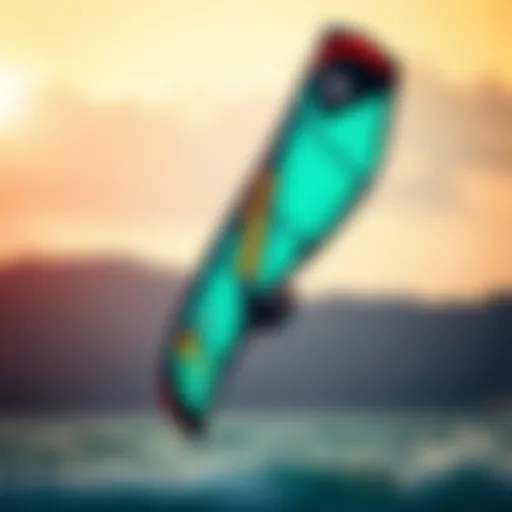Exploring the Dynamics of 3 Line Trainer Kites
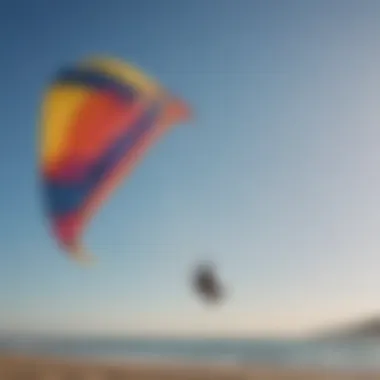

Intro
Training with 3 line trainer kites offers a unique gateway into the broader world of kiteboarding. These kites, simple yet effective, allow novices to build essential skills safely. Instead of diving headfirst into the complexities of traditional kites, beginners can familiarize themselves with wind dynamics, control techniques, and kite handling in a more manageable context.
In the kiteboarding community, 3 line trainer kites are recognized for their role in bridging the gap between learning the ropes and mastering the sport. The three lines—two for steering and one for braking—create an intuitive flying experience that enhances understanding of responsive kite control. It’s not just a matter of flying kites; it’s about mastering the art of it. Thus, unpacking the various aspects of these kites, from gear selection to skill development, can pave the way for future successes on the water.
Gear Selection
Choosing the right gear can seem like a daunting task for those starting with 3 line trainer kites, but it's a crucial first step in your kiteboarding journey. The right tools not only enhance your experience but also ensure your safety as you learn.
Types of Kites
When it comes to trainer kites, options abound, but most can be categorized into several distinct types:
- Foil Kites: These kites inflate using wind, creating an airfoil that gives them lift. They’re lightweight, durable, and often easier to handle for beginners.
- Leading Edge Inflatable (LEI) Kites: While typically used for more advanced setups, some models cater to beginners. Their structure allows for greater stability and power once mastery is achieved.
- Single-Layer Kites: These are generally the simplest and most user-friendly. A great choice for absolute beginners, as they have fewer complications in setup and are more forgiving on the learning curve.
Most enthusiasts recommend sticking with well-known brands to ensure quality and reliability.
Choosing the Right Board
Selecting the right board complements your kite experience. The board should balance comfort and control, while also accommodating your skill level. Consider the following:
- Beginner Boards: Wider and more stable, these boards help maintain balance while you're still finding your footing. They often come with softer flex to make them forgiving on landings.
- Advanced Boards: As skills grow, you might look into more performance-oriented boards. These are typically lighter and more responsive, allowing for tricks and faster maneuvers.
A good fit isn't merely about size—it's also about how it feels under your feet while riding.
Skill Development
Mastering the nuances of 3 line trainer kites isn’t just about flying; it’s about understanding the essential techniques that lead to progression in the sport.
Essential Techniques
For newcomers, certain fundamental techniques can drastically enhance your experience:
- Launching and Landing: Understanding how to safely launch and land your kite is paramount. Practice coordinating your movements with the wind direction, keeping your body in sync with the kite's behavior.
- Wind Awareness: Developing a keen sense of wind shifts and currents helps cyclists anticipate changes and react accordingly. Being sensitive to environmental cues is a skill that pays dividends.
- Trimming: Learning how to adjust your kite's lines will allow you to maintain optimal performance. Trim adjustments can mean the difference between a controlled flight and a wayward drift.
Progression Tips
After feeling comfortable with the basics, it’s time to think about progression. Here are some pointers to elevate your skills:
- Frequent Practice: The more time spent flying your kite, the better you’ll master nuances. Regular practice builds muscle memory.
- Seek Feedback: Engaging with experienced kiteboarders or instructors can provide insights you might miss on your own.
- Conditions Matter: Experiment in different wind conditions to fully understand how your kite behaves. Knowledge of how various weather aspects influence your flight can help solidify your understanding.
"It is not always about the speed at which you progress; rather, it’s about safe and steady growth in skills that truly counts."
Understanding these elements lays the groundwork for a successful experience with 3 line trainer kites and can significantly enrich your kiteboarding adventure.
Foreword to Trainer Kites
In the realm of kiteboarding, trainer kites serve as a crucial building block for enthusiasts looking to master the sport. These kites not only introduce beginners to the mechanics of kite flying but also provide a platform to develop essential skills that are transferable to larger, more powerful kites. Understanding trainer kites is fundamental for anyone wishing to deepen their engagement with kiteboarding. By diving into this subject, we can appreciate the significance of these devices, their unique features, and their role in skill progression for both novices and experienced riders.
Definition and Purpose
Trainer kites are small, lightweight kites designed specifically for instructional purposes. They typically range from 1.5 to 3.5 meters in size and are controllable through a system of lines, allowing beginners to learn fundamental flying techniques in a safe and controlled manner. The primary purpose of a trainer kite is to familiarize the user with various aspects of kite control, which include steering, stopping, and positioning the kite in relation to the wind. This foundational understanding is pivotal as it prepares the user for more advanced kiting skills, significantly enhancing their capability when they transition to larger kites equipped for power surfing.
The simplicity and forgiving nature of trainer kites make them perfect for those just starting. It’s like learning to ride a bike with training wheels; the experience builds confidence as one learns to maneuver and respond to the kite’s behavior—as the saying goes, you can't manage what you can't measure! By mastering the basics with a trainer kite, a rider lays the groundwork for tackling more complex scenarios.
History of Trainer Kites
The evolution of trainer kites traces back to early kite flying and sports developments, where small kites were used for recreational purposes. However, the real pivot towards structured training tools began in the 1970s and 1980s as the sport of kiteboarding emerged. Pioneers in the sport recognized the need for effective educational tools to help new riders assimilate skills safely.
As kiteboarding gained traction, manufacturers developed trainer kites that served dual purposes: they were both learning devices and recreational kites. The designs evolved to include functions that allowed users to practice flying techniques without the overwhelming power of full-sized kites. By the 1990s, trainer kites began to gain popularity in kite schools, emphasizing the importance of safety and skill transfer in comprehensive training programs.
Over the years, materials and designs refined dramatically, leading to the versatile trainer kites available today. With continuous innovation, modern trainer kites offer excellent stability, responsiveness, and durability, making them indispensable tools for both educators and aspiring kiteboarders alike.
Understanding the historical context of trainer kites adds depth to our appreciation of their current role in kiteboarding, emphasizing that they are not just toys but vital instruments in the progression of kiting skills.
Understanding Line Trainer Kites
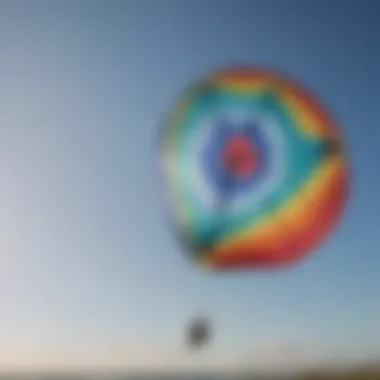

Understanding the intricacies of 3 line trainer kites lays the foundation for both novices and seasoned kiteboarders. These kites are not just toys for the wind; they serve a critical role in honing skills and understanding the dynamics of aerial navigation. Getting to grips with the various aspects of these kites helps kiteboarders make informed decisions, leading to an enhanced experience on the water.
Design Features
The design of 3 line trainer kites is a marvel of engineering, combining both simplicity and functionality. Unlike their two-line counterparts, these kites are equipped with an extra control line, providing enhanced stability and maneuverability.
- Three Lines for Precision Control: The third line permits the pilot to steer and adjust the kite in more dynamic ways. This feature gives beginners a chance to learn how to respond to changing conditions efficiently.
- Material and Construction: Typically made from ripstop nylon and reinforced stitching, trainer kites are built to withstand the rigors of both novice handling and environmental factors. They are lightweight, which aids in easier launch and recovery.
- Size Options: Depending on the design, these kites come in various sizes, allowing pilots to choose based on their weight and wind conditions. A larger kite generally catches more wind, ideal for lighter wind days, while smaller kites cut through stronger gusts.
Having a keen awareness of these design elements equips novices not only to pick the right kite but also to appreciate the subtleties of handling and flying that comes with experience.
Operational Mechanics
When it comes to how a 3 line trainer kite actually works, the mechanics provide a window into kiteboarding fundamentals. Here are key elements:
- Launching: To launch a 3 line kite, the pilot typically holds the lines in one hand while using the other to guide the kite into the wind. The design allows for a straightforward launch, where the kite can rise quickly if flown correctly.
- Flying Techniques: Once airborne, the control line enables the pilot to adjust the angle of attack. Pulling on the back line pitches the kite upwards, while releasing creates descent. Such immediate responsiveness forms the bedrock of effective kite control.
- Wind Pressure: The importance of wind pressure is paramount. It enables the kite to generate lift. Understanding how various wind conditions affect the kite’s behavior helps in preventing erratic flight paths and potential crashes.
"Flying a trainer kite is about reading the wind and adjusting your actions accordingly; it's the first step in your kiteboarding education."
- Recovery: Upon descent, the 3 line setup allows for smoother recovery. Pilots can revert to a neutral position efficiently, maintaining control and delicate handling even as they land.
Grasping these operational mechanics is crucial for a seamless transition from trainer kite to full-sized kites hereafter. Every session spent practicing with a 3 line trainer kite refines skills and increases the overall safety of the kiteboarding experience.
By delving into the design and intrinsic operational mechanics of 3 line trainer kites, enthusiasts can cultivate a deeper understanding, elevating both enjoyment and proficiency in the exciting, wind-driven world of kiteboarding.
Advantages of Line Design
The three-line design in trainer kites offers a myriad of advantages that enhance both the safety and learning experience for beginners. The practicality that comes from this setup has been a game changer for many enthusiasts venturing into the kiteboarding realm. Understanding these benefits can significantly impact one’s progression and enjoyment in the sport.
Stability and Control
Stability is one of the hallmark features that sets the three-line kites apart from their counterparts. By incorporating an additional line, the control a rider has over the kite is significantly boosted. This is not just a small iteration; it becomes a substantial factor when you’re out amidst fluctuating wind conditions.
- Enhanced Response: With one line dedicated to managing the depth of the kite in the wind, enthusiasts can tailor their flight experience more precisely. The kite behaves more predictably, allowing for smoother transitions in maneuvering.
- Greater Precision: Unlike two-line kites that might buck and dive when the wind shifts, a well-tuned three-line setup provides a responsive feel. This means if a gust comes out of nowhere, the kite can be reeled back quickly, minimizing potential issues.
- Beginners’ Advantage: Many beginner kiteboarders can attest to their initial fears while launching. A three-line design mitigates this anxiety. The stability and control allow newbies to focus more on the mechanics of flying rather than worrying about losing control of their kite.
"A stable kite is like training wheels for a bike; it gives new riders the confidence they need to build their skills."
Ease of Launch and Recovery
Launching and retrieving the kite can often be the most daunting aspects for newcomers, but a three-line trainer kite simplifies these processes effectively. This ease of use can be vital in a beginner's journey toward becoming a skilled kiteboarder.
- Simplified Launch Mechanics: The third line can serve as a brake during the launch. By managing the lines, the flyer can release tension gradually, leading to a more controlled ascent into the air. This prevents the kite from launching prematurely or inconsistently, which is common in two-line kites.
- Accommodates Changing Conditions: When the wind doesn't play nice, and the kite needs to be reeled in, a three-line setup allows the flyer to easily depower the kite. This feature ensures that the kite can be controlled even when conditions become unfriendly, making it easier for anyone to recover the kite safely without much hassle.
- Efficiency in Recovery: Upon landing, the ability to quickly stabilize the kite is crucial. The third line facilitates a swift drop — it’s less about fighting with the winds and more about making an ace landing, turning a potentially chaotic situation into an organized process.
These advantages collectively underscore why the three-line design is preferred among novice and seasoned kiteboarders alike, marrying function with safety and setting the stage for a gratifying learning experience in kiteboarding.
Types of Line Trainer Kites
Understanding the different types of 3 line trainer kites is essential for anyone looking to elevate their kiteboarding skills. These kites not only serve as a tool for learning the ropes but also enhance the overall experience by providing stability, control, and optimal learning conditions. Each kite design has its unique advantages and is suited for various wind conditions and skill levels, making it crucial to choose wisely.
Foil Kites
Foil kites represent a popular choice among beginners and seasoned kiteboarders alike. Unlike traditional framed kites, foil kites are constructed of a canopy that relies on air to maintain its shape, creating multiple cells that enable efficient airflow. This design allows for a lighter kite that can be packed down smaller, making transport hassle-free.
A few notable characteristics of foil kites include:
- Lightweight Construction: Made from durable yet lightweight materials, they are easy to maneuver, especially for those starting out.
- Simplicity: With no rigid frame, they require less maintenance and are often easier to assemble.
- Versatile Performance: Foil kites can operate efficiently in a wide range of wind conditions, making them suitable for various environments. They provide consistent pull, allowing novice kiteboarders to focus on mastering basic skills without excessive distractions.
The benefits of using foil kites extend beyond just their design features. Many users note that the smooth flying characteristics allow for an intimate connection to the wind, fostering greater confidence during initial training sessions.
Leading Edge Inflatable Kites
Leading edge inflatable kites, often abbreviated as LEIs, are another major category in the realm of 3 line trainer kites. These kites boast an inflatable leading edge that holds air, helping the kite maintain its shape and providing added stability during flight.
Key attributes of LEIs include:
- Enhanced Stability: The inflatable structure tends to offer better stability, making it easier for beginners to develop their flying skills without the kite dropping unexpectedly.
- Bigger Wind Range: They can perform well in various wind speeds, making them ideal for different flying conditions.
- Control and Responsiveness: LEIs have a powerful pull and are highly responsive to steering inputs, which is beneficial as the pilot begins to learn more advanced techniques.
"Choosing the right type of trainer kite can significantly affect your learning curve and enjoyment of the sport."
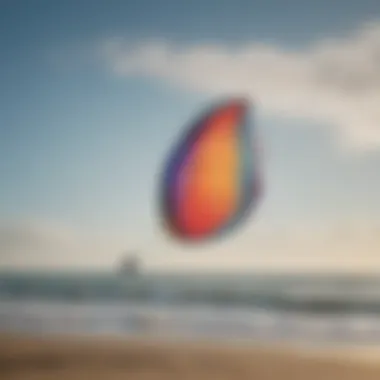

Both types, foil and LEI kites, provide unique training experiences and advantages. As you eye your next purchase or kite choice, weigh the specifics—like where you’ll be flying most often and what conditions your skill level best suits.
In summary, the type of 3 line trainer kite you choose will play a substantial role in your progress and enjoyment in kiteboarding. Whether you prefer the lightweight nature of foil kites or the stability of leading edge inflatables, understanding their differences aids in making an informed decision.
Selecting the Right Trainer Kite
Choosing the right trainer kite is a pivotal step for anyone interested in kiteboarding, especially for those just starting out. It's not just about picking a kite that looks good; there’s a whole heap of factors involved that can significantly impact a beginner's learning curve. The wrong kite can lead to frustration instead of the joy that kiteboarding promises. By understanding the various elements and considerations that go into selecting a trainer kite, novice kiteboarders can set themselves up for a more enjoyable experience.
A well-suited trainer kite can foster confidence, facilitate better control, and provide quick feedback, all of which are essential when learning to navigate the winds. Here are a couple of important points to keep in mind when looking for the right kite.
Size Considerations
When it comes to size, the choice often boils down to the rider's weight and the prevalent wind conditions. Generally speaking, larger kites can capture more wind, making them more suitable for lighter individuals in lighter winds. Conversely, heavier riders might need a smaller kite to maintain control and avoid being overwhelmed, particularly in fresher breezes.
- Light Wind: If the wind is light, you might want to consider a larger kite. Typically, kites in the 2.5m to 4.5m range are favorable for these conditions. They allow for easy lift and help beginners keep the kite aloft.
- Strong Wind: On the flip side, for gusty winds above 20 knots, a smaller size kites, around 1.5m to 3.0m, provide better handling. They’re less likely to pull excessively hard, giving the learner a sense of control while mastering their skills.
It's wise to take into account the kite's aspect ratio too; kites with a lower aspect ratio tend to be more stable, making it easier for newcomers to learn the ropes.
Wind Conditions
Understanding wind conditions is equally crucial as selecting the appropriate size. Different wind speeds and patterns can create entirely different flying experiences. Beginners often underestimate the strength of the wind and its effect on control and stability.
- Light Winds: In gentle breezes (below 10 knots), a larger trainer kite will help generate lift and keep the kite in the air longer. The rider should expect slower responses from the kite, which can be beneficial for learning basics without feeling overwhelmed.
- Moderate to Strong Winds: When dealing with winds between 10-20 knots, understanding the kite’s response becomes paramount. Here, learners might want to go with kites that respond quickly but manage in tuning the tension to avoid being pulled too hard.
- Gusty Winds: Gusts can be tricky. It's advisable to opt for kites engineered with stability enhancing features. These kites better handle turbulent airflow, ensuring better reactions without sending the novice spiraling.
"Selecting the right trainer kite based on size and wind conditions is crucial for a smooth start in kiteboarding. The right equipment can make a world of difference in building the necessary skills while having a blast on the water."
Having a grasp on kite size alongside wind conditions will aid in making wise choices that fit the rider’s needs. Overall, these considerations play a vital role in ensuring that the experience matches one's skills and confidence level.
Training with a Line Trainer Kite
Training with a 3 line trainer kite is essential for novice and experienced kiteboarders alike. This segment of the kiteboarding journey equips enthusiasts with the skills they need to harness the wind's power effectively and safely. A 3 line design offers a greater level of control, making it an ideal choice for first-time flyers. Understanding how to operate this specific kite type lays the groundwork for more advanced techniques in the future.
A key benefit of using a 3 line trainer kite is the enhanced stability it provides during flight. This design allows beginners to focus on fundamental skills without being overwhelmed. Moreover, it caters to the wind's whims far better than a traditional 2 line kite. Prioritizing training using a 3 line kite can significantly decrease the learning curve, setting a solid foundation for future kiteboarding experiences.
By diving into the nuances of control during training, individuals also gain confidence, which is paramount in any adventure sport. It’s important to emphasize that training isn't merely about mastering techniques; it’s about building a relationship with the kite, understanding its quirks, and developing a sense of timing and balance.
Basic Skills Development
Mastering basic skills when using a 3 line trainer kite is crucial for establishing a strong foundation in kiteboarding. One of the first things to grasp is the essential maneuverability the kite offers. Learning how to work with the 3 lines — the control line, the brake line, and the flying line — allows the flyer to manipulate the kite’s position in the sky effectively.
Here are the fundamental skills to focus on:
- Launching: Getting the kite into the air is a primary skill. It often involves knowing how to position the kite so that the wind lifts it smoothly.
- Steering: Understanding how to navigate the kite around the wind window is key. Properly using the control lines influences the kite's direction and altitude.
- Landing: Just as important as launching, executing a controlled landing can make or break a training session. Recognizing wind changes and adjusting accordingly is vital for safe landings.
Practicing these skills enables beginners to connect with their kite on a more significant level. As they become familiar with the kite’s behavior, their reactions and decision-making skills will sharpen. Rigorous practice also fosters muscle memory, which is invaluable when transitioning to more complex maneuvers.
Progressing to Advanced Techniques
As beginners become comfortable with the basic skills, they can transition to more advanced techniques that 3 line trainer kites facilitate. Once the foundational skills are in place, the learning experience expands as kiteboarders can explore various dynamic movements and tricks.
Here are some advanced techniques to explore:
- One-handed Steering: Being able to steer the kite with one hand while maneuvering the board or preparing for jumps can free up the other hand for tricks.
- Jumping: Familiarity with power control can lead to successful jumps. Learning to harness wind power enables smooth take-offs and landings, making these jumps exciting.
- Power Control: Efficiently navigating different wind conditions while maintaining optimal power input allows for advanced aerial tricks.
As kiteboarders progress, the emphasis shifts from simply controlling the kite to incorporating it into an overall riding strategy. The fun part of mastering these advanced techniques is the challenge it brings along with the lessons learned during each mishap.
"The kite doesn't just fly; it dances with you, teaching you the rhythm of the wind and the importance of balance."
Training with a 3 line trainer kite not only sharpens one's skills but also opens doors to explore creativity in kiteboarding. The journey starts with the fundamentals, but with patience and practice, it evolves into a thrilling rave on the water that showcases one's hard-earned skills.
Safety Considerations
When it comes to kiteboarding, safety isn’t just a checklist item; it’s a fundamental aspect that can make or break your experience. 3 line trainer kites, with their unique design and functionality, provide an exceptional platform for learning and mastery, but they also come with specific safety considerations that every user should be acutely aware of. Whether you are a novice or a well-versed practitioner, understanding safety measures not only protects you but also those around you in the kiteboarding community.
Pre-Flight Checks
Before you launch into the skies, make sure you haven’t skipped the pre-flight checks. Think of it as a warmup—just like you wouldn’t go running without stretching, don’t fly without a few vital checks. Here’s a handy list of what to look at:
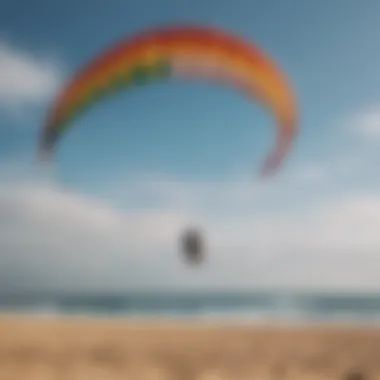

- Inspect the Kite: Check the fabric for any tears or holes, especially around the seams where wear can accumulate. A small issue can become a big problem in the air.
- Lines and Connectors: Ensure that the lines are untangled and that there are no frays or abrasions. Inspect the connectors to confirm that they are intact.
- Wind Conditions: Familiarize yourself with the wind speed and direction to ensure they match what your trainer kite can handle. For instance, if the breeze is howling, you might want to hold off.
- Safety Gear: Put on your harness, helmet, and other protective wear. Remember, it’s better to be safe than sorry. A quick scan of your gear can save you from unnecessary injury.
In summary, these pre-flight checks are crucial. Skipping them can lead to equipment failure, which could potentially endanger your safety, as well as that of other kiteboarders nearby. A few mins spent checking equipment can equate to hours of fun without incident.
Emergency Procedures
Even the best-laid plans can go awry, which is why knowing your emergency procedures is paramount. Think of this as your go-to toolbox when things take an unexpected turn. Here are some essential steps to follow:
- Deploy the Quick Release: If you feel that something is off, your first move should be to activate the quick release on your harness. This action releases tension and detaches you from the kite, allowing you to regain control.
- Land Safely: If your kite is still in the air but you’ve lost control, attempt to safely land it. Angle the kite to the side into the wind. Choose your landing spot wisely, avoiding beachgoers and obstacles.
- Seek Help: If things go south and you find yourself in a bind, alert fellow kiteboarders nearby. Pay attention to their signals and advice — they could offer life-saving insights.
Remember: Kiteboarding is an exhilarating sport, but safety must always be a priority. Being prepared can keep your adventures enjoyable and incident-free.
By adhering to these safety considerations, you enhance not only your own experience but also contribute to a safer kiteboarding community. Embrace the thrill of the wind while keeping safety at the forefront of your mind.
Environmental Impact and Responsibility
Understanding the impact of kiteboarding on our environment is crucial for enthusiasts and for the sustainability of the sport itself. The rise of 3 line trainer kites has made it easier for newcomers to learn and enjoy this exhilarating activity. However, with increased participation comes a responsibility to protect the natural places that provide our playgrounds. Thus, discussing Environmental Impact and Responsibility focuses on how kiteboarding can positively or negatively affect these spaces and the steps we can take to minimize our footprint.
Sustainable Practices in Kiteboarding
Sustainability isn't just a buzzword; it's a commitment. Kiteboarders can embrace sustainable practices in several ways to ensure our sport remains viable for years to come. Here are a few strategies:
- Choose Eco-friendly Gear: Many manufacturers are now producing kites using environmentally safe materials. Instead of going for cheaper, single-use plastics that take centuries to break down, opt for brands that prioritize eco-friendly production methods.
- Adopt Responsible Travel Practices: If your kiteboarding adventures take you to beautiful coasts or lakes, aim for minimal impact while traveling. This includes staying on marked paths, avoiding littering, and maybe even participating in local clean-up efforts.
- Educate Yourself and Others: Knowledge is power. Understanding the environmental issues related to recreation in natural areas helps promote better behaviors. Come together with fellow kiteboarders to raise awareness about the local ecosystems and how to protect them.
By implementing such sustainable practices, kiteboarders not only enhance their sport experience but also contribute to preserving the very environments we cherish.
Respecting Natural Habitats
Every kiteboarder knows the thrill of wind beneath their wings, but it’s essential to recognize the habitats that surround us. Respecting natural habitats involves being mindful of the wildlife and ecosystems that share these spaces. Key points to consider include:
- Avoid Disturbing Wildlife: Kiteboarding sites often support diverse wildlife. Various shorelines or coastal regions may host nesting birds or provide essential feeding grounds for other creatures. Always maintain a safe distance from wildlife to prevent distress or disruption.
- Follow Local Regulations: Many beach areas have specific guidelines for recreational use to safeguard natural habitats. Make sure to be informed and comply with any posted notices or local bylaws regarding access to sensitive areas.
- Promote Conservation Initiatives: Get involved with local conservation groups or participate in programs aimed at preserving marine environments. Engaging with these initiatives fosters community efforts and enhances the health of our natural surroundings.
"Acting as good stewards of our environment guarantees future kiteboarders can continue to experience the joy of the sport while preserving the beauty of nature."
When we respect natural habitats, we foster a healthy connection between our sport and the outdoors. Ensuring that our actions today do not harm the environments of tomorrow should guide every kiteboarding adventure.
Community and Resources
Navigating the vast landscape of kiteboarding, specifically through the lens of 3 line trainer kites, beckons the importance of community and the resources available to enthusiasts. Knowledge and support can significantly enhance the kiting experience, ensuring that both beginners and seasoned kiteboarders make the most of their time spent on the water. The community aspect is not just about fostering friendships but also about sharing valuable insights, experiences, and techniques that contribute to safer and more enjoyable kiteboarding.
Connecting with Other Enthusiasts
One of the most beneficial elements of engaging in the kiteboarding community is connecting with fellow enthusiasts. Whether through local clubs, online forums, or social media platforms like Facebook and Reddit, these connections serve as a gold mine for information. Here are some advantages of building these relationships:
- Knowledge Sharing: Engaging with more experienced kiteboarders allows you to learn from their journeys, mistakes, and triumphs.
- Event Participation: Being part of a community often opens doors to various events, from friendly competitions to organized group outings.
- Support and Safety: In a sport that comes with its share of risks, having a community can provide crucial support in ensuring safety during practice.
Getting involved in discussions, attending meet-ups, and reaching out to others can make the world of kiteboarding feel a lot more accessible.
Accessing Learning Materials
Learning and improving one's skills is a continuous journey in kiteboarding. Luckily, a plethora of resources exists to help enthusiasts get a grip on both the basics and advanced techniques related to 3 line trainer kites. Here are some essential places to look:
- Online Courses: Websites dedicated to kiteboarding often offer structured courses that guide individuals through the learning process step-by-step.
- Videos and Tutorials: Platforms like YouTube house countless instructional videos created by seasoned kiteboarders, providing visual guides that are easier to follow than written instructions. Some channels focus specifically on trainer kites, giving viewers tailored information.
- Books and Articles: For those who prefer reading, engaging with kiteboarding literature can deepen understanding and provide unique tips and strategies. Resources from Britannica can yield scholarly articles about the evolution of kiting techniques and equipment.
- Forums and Blogs: Engaging in kiteboarding forums allows users to post questions and receive advice directly from the community. Blogs often contain personal experiences that can be quite illuminating and relatable.
"Learning from others' experiences can often save you from learning the hard way yourself."
Connecting with others and accessing a variety of learning materials not only fortifies one's skills but also enhances the overall kiteboarding experience. Together, these resources cultivate a richer understanding of 3 line trainer kites and their capabilities on the water.
Culmination
As we draw our exploration to a close, it’s vital to reflect on the significant contributions of three line trainer kites to the kiteboarding landscape. Understanding these kites not only enhances the skill set of the rider but also enriches the overall kiteboarding experience. These vehicles of fun and excitement possess unique characteristics that cater particularly to novices, yet they are designed with enough depth to keep seasoned enthusiasts engaged.
Recap of Key Points
In revisiting the essential elements discussed throughout, here’s a succinct recap:
- Definition and Purpose: Trainer kites serve as a bridge, easing beginners into the sport while honing their skills.
- Design and Mechanics: The three line system provides improved control and stability, setting it apart from other kite styles.
- Advantages: Their ease of launch and recovery makes them an ideal choice for those just beginning their journey in kiteboarding.
- Types of Trainer Kites: Whether foil kites or leading edge inflatables, each variety comes with its own set of benefits, catering to diverse preferences.
- Safety and Responsibility: Ensuring safe practices is non-negotiable, helping to preserve both the environment and the kiteboarding community.
This all serves to create not just an individual sport, but a thriving community.
Future of Trainer Kites in Kiteboarding
Looking forward, the evolution of trainer kites seems promising. Advances in materials and design are likely to enhance their functionality further. Innovations such as lightweight structures and improved aerodynamic shapes could pave the way for even greater performance. As the kiteboarding community grows, so too will the role of trainer kites within it, possibly expanding to include newer models that emphasize eco-friendliness and sustainability. Moreover, as more sports enthusiasts recognize the benefits of starting with trainer kites, we might see a surge in events and competitions centered entirely around these models, fostering an enthusiastic environment for learning.
Whether you’re a newcomer or a seasoned pro, the journey with 3 line trainer kites has just begun. Exploring this niche might uncover new techniques, skills, and perhaps even a deeper appreciation for the art of kiteboarding itself.



